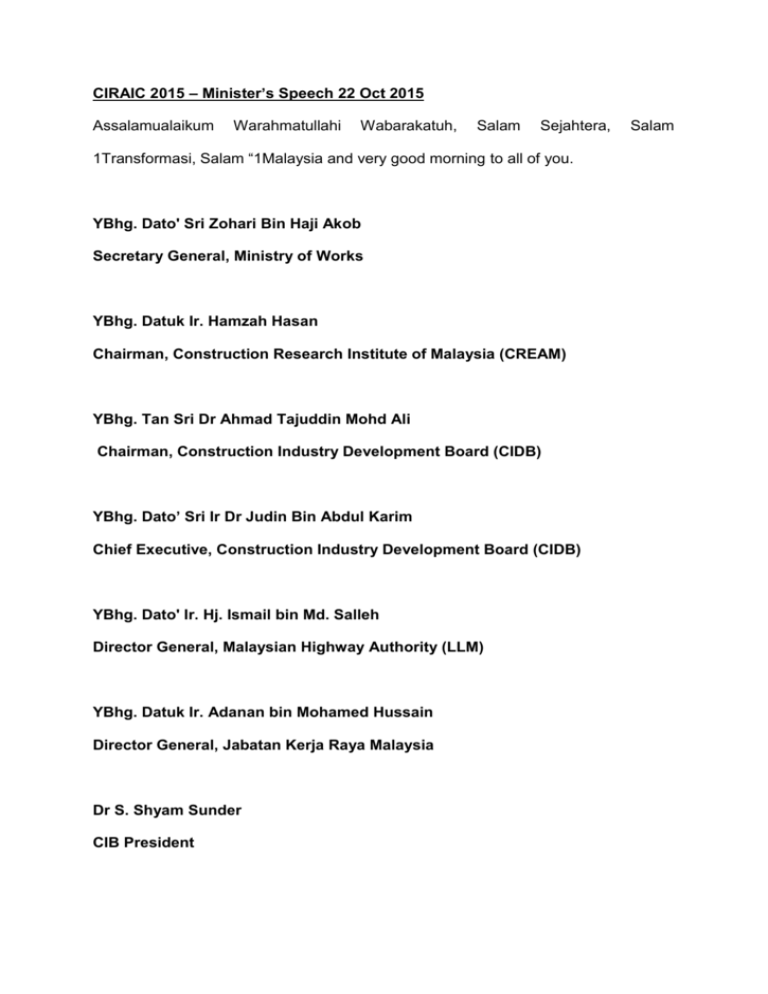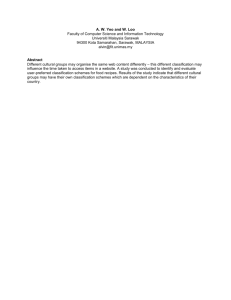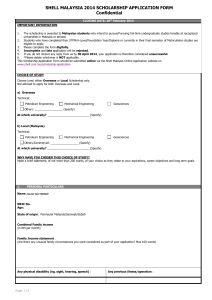CIRAIC 2015 – Minister's Speech 22 Oct 2015
advertisement

CIRAIC 2015 – Minister’s Speech 22 Oct 2015 Assalamualaikum Warahmatullahi Wabarakatuh, Salam Sejahtera, 1Transformasi, Salam “1Malaysia and very good morning to all of you. YBhg. Dato' Sri Zohari Bin Haji Akob Secretary General, Ministry of Works YBhg. Datuk Ir. Hamzah Hasan Chairman, Construction Research Institute of Malaysia (CREAM) YBhg. Tan Sri Dr Ahmad Tajuddin Mohd Ali Chairman, Construction Industry Development Board (CIDB) YBhg. Dato’ Sri Ir Dr Judin Bin Abdul Karim Chief Executive, Construction Industry Development Board (CIDB) YBhg. Dato' Ir. Hj. Ismail bin Md. Salleh Director General, Malaysian Highway Authority (LLM) YBhg. Datuk Ir. Adanan bin Mohamed Hussain Director General, Jabatan Kerja Raya Malaysia Dr S. Shyam Sunder CIB President Salam Ladies and gentlemen. It is indeed a pleasure for me to be here at the 4th Construction Industry Research Achievement International Conference (CIRAIC 2015), an annual initiative by the Construction Research Institute of Malaysia (CREAM), the research arm of the Construction Industry Development Board (CIDB). 2. Let me also take this opportunity to congratulate CIDB, CREAM and their partners for a remarkable effort in organising this international conference which is in its 4th year as the leading platform in gathering of top industry minds and stakeholders to share new ideas, achievements and best practices. 3. I am pleased with the excellent support and response by the local and international construction industry players and is confident your presence here in Kuala Lumpur will be a fruitful experience and that this conference will be yet another great success. 4. The indication is that sustainable construction is on track to become the main stream of the global construction industry. Our collaboration with the International Council for Research and Innovation in Building and Construction (CIB), the world’s foremost association in stimulating and facilitating international collaboration and information exchange between governmental research institutes in the building and construction sector is a strategic way forward. As such, I believe this initiatives will further elevate CIRAIC and escalate into a bigger conference for sustainable construction on the global stage. Ladies and gentlemen, 5. Sustainable construction is the need to find a balance between economic, environmental and social factors in the design, construction and use of buildings. This year’s theme of CIRAIC 2015, Sustainable Construction Beyond 2020 has a central role in driving the global sustainable development agenda where researches have found that 40% of the total world energy consumption is initiated from built environments, while real estate was found to contribute to about 20% of CO2 emissions via energy use, waste and water production. As a member of the global society, Malaysia is expected to face the same environmental challenges as we head towards a developed nation status. Therefore, the call for sustainability must be taken seriously by the whole supply chain of the construction industry for us to protect our quality of life and social well-being. 6. In moving forward, the Government through the Ministry of Works Malaysia and the CIDB under the 11th Malaysia Plan (11MP) will implement the Construction Industry Transformation Programme (CITP) which focuses on growing Malaysian companies’ capabilities, capacity and competitiveness. By 2020, our target is to transform Malaysia’s construction industry to be at par with the very best in ASEAN. The CITP thus incorporates sustainability and internationalization among four of its thrusts, which are: (i) raising the overall productivity level of the industry; (ii) ensuring environmental sustainability measures are in place in the design, construction and subsequent maintenance of our buildings, infrastructure and cities; (iii) focusing on improving the competitiveness and subsequent ability of our construction players to internationalize; and (iv) improving the overall quality, safety, and professionalism in the industry. 7. Under the Environmental Sustainability thrust of the CITP, Malaysia’s commitment to sustainability in the construction sector is addressed by developing and promoting programmes and initiatives that encourages more sustainable infrastructure projects. The Ministry of Works will continue to support these efforts through excellence in green building programmes and push for the increase in the design and construction of greener buildings in the country. Ladies and gentlemen, 8. I am happy to inform that the Malaysian construction industry continued to outperform other economic sectors and believe that the industry will remain attractive in years to come as the construction sector is poised to be one of the major beneficiary of the 11th Malaysia Plan (11MP) as most of the development expenditure will be infrastructure-centric. The robust performance underscores the important role of the construction industry in driving the Government’s Economic Transformation Programme (ETP) towards Malaysia’s goal of becoming a high income and developed nation by the year 2020. 9. However, economic achievements and physical development are only an integral part of our national development and a lot more needs to be in place in becoming a developed nation. Similarly, a sustainable construction industry should be capable of building assets that meet present day needs and serving for generations, while preserving the environment it operates in. 10. In this respect, the construction industry players must not limit their discourses on how they get a facility built but must think about how to get something built by taking into account cultural economic, environment, social, and technical perspectives. This is why I believe the time is right to have CIRAIC 2015, not just to promote Malaysia as a regional hub for sustainable construction but also to establish research partnership and collaboration among industry players in the country as well as worldwide. The industry’s experts sharing their thoughts on sustainable construction will provide us the latest information on green revolution in the construction industry as well as limitless insights on green building technologies that help to reduce the significant impacts of building on urban life and global environments. Ladies and gentlemen, 11. Apart from the latest technology, lessons learnt and best practices on infrastructure resilience to natural disaster are critical in response to the severe effects of the natural catastrophes in Malaysia recently. This again is a reminder that sustainability needs to be embraced into the country’s construction industry for the people’s wellbeing. Sustainable construction is not just limited to reducing environmental impacts of a building over its entire life span but also takes into consideration the safety of its occupants and its capability to withstand unforeseen disaster. 12. Another issue that is important to the Government is the provision of adequate quality housing for the mass population in the country. As a developing country, Malaysia is of no exception in facing mass housing problems when moving towards higher level of urbanization. In realizing that sustainability is increasingly embedded into building regulations, the Government’s long term solution is for us to integrate the principles of affordability and sustainability in meeting the national aspirations of meeting the demands and expectations of the citizens. Ladies and gentlemen, 13. I would like to applaud CIDB and CREAM for initiating the research on “Developing Affordable and Sustainable Housing for Middle Income Group in Malaysia through Divergent Dwelling Design Architectural Concept” in addressing the shortcomings in current housing developments by taking into account the design process, construction process and the flexibility for future development. It is hoped that such research will not only stimulates the development of the building industry but also facilitates the industry moving towards mechanization, modernization, and industrialization. 14. In embracing technology, one of the platform that I am confident can yield great potential is Building Information Modelling (BIM) which can assist us in delivering more innovative, cost-efficient buildings and commissioning of buildings with lower environmental impacts. This is because accurate information sharing can enable all the stakeholders to conduct their daily tasks with higher efficiency, more sustainable and with lesser environmental degradation. Most importantly, it can transform our construction industry through integrating information and collaboration of the project owner, developer, planner, designer, builders and surveyors. Ladies and gentlemen, 15. In conjunction with the CIRAIC 2015, CREAM will be launching the Peat Soil Guideline aimed at policy makers, state authorities, developers and industry players when constructing in peat soil areas. The guideline is a compilation of information on peat soil distribution in Malaysia, providing suggestions on soil investigation and testing practices and design considerations for construction development on peat soil. 16. As we know, one of the challenges in the construction of the RM27 billion Pan Borneo Highway is the existence of a large portion of peat soil areas and therefore is vital for us to handle peat soil with proper care in order to avoid cost overruns and maintenance problems in the future. With the launching of the Peat Soil Guideline, it is timely that industry players can now have access to useful knowledge and information in the handling and management of peat soil for the construction of roads, bridges and infrastructure. Ladies and gentlemen, 17. The opportunities to embrace sustainable development are vast. I am sure our valuable speakers and experts will be able to share with you their experiences, ideas, and thoughts in today’s conference. I look forward to CIRAIC 2015 in providing new ideas and partnerships in the spirit of our theme and look forward to your presence again next year. 18. To our guests from abroad, participants, delegates and colleagues, I invite all of you to seek partnerships and alliances with Malaysian companies to pursue ventures not only in Malaysia but also within the region and the world. I hopeful you will all benefit from this meeting of minds, market of ideas and derive opportunities at this conference which will result in collaboration amongst the industry players in Malaysia and the region. 19. At this juncture I would like to record my appreciation to the following organisations in no particular order for facilitating CIRAC 2015 - Sime Darby Property, Public Works Department, The Institute of Engineers Malaysia (IEM), Agensi Nuklear Malaysia, Master Builders Association Malaysia (MBAM), Jabatan Kedua Sdn. Bhd., Real Estate and Housing Developers’ Association Malaysia (REHDA), Royal Institute of Surveyors Malaysia (RISM), Lembaga Jurutera Malaysia, Lembaga Lebuhraya Malaysia, Institute for Environment and Development UKM, Akademi Sains Malaysia, MySet, Lembaga Arkitek Malaysia, and Lembaga Juruukur Bahan Malaysia. 20. Finally, I would like to thank the organizing committee once again for successfully hosting this conference. With the lafaz of bismillah irrahmanirrahim I, hereby declare the CIRAIC 2015 officially open. Thank you. Wabillahitaufik Walhidayah Wassalamualaikum Warahmatullahi Wabarakatuh






